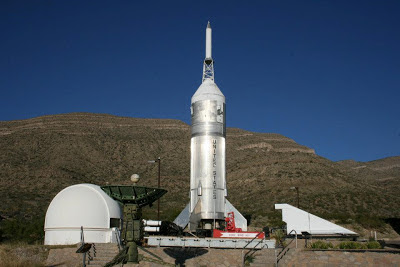The New Mexico Museum of Space History has an impressive location on a mountainside in Alamogordo. It is a modern structure that has a science and technology appearance. It is full of windows, with great views overlooking the mountains, desert, and Alamogordo. The entrance fee for adults is $6.00, but there are senior and military discounts. Your receipt is good for a second visit the following day. An elevator takes you to the spacious fourth floor where you begin a self guided tour and walk down easy ramps to each lower level. From the first floor an elevator will take you to the ground floor where there is a gift shop. Roy and I thought the elevator ride up was worth the admission price for the museum! The elevator surprised us with sounds that made us feel as though we were being taken up for departure on a space ship! A bit startling at first, but then very cool! We thought about a return visit the next day just to ride the elevator!
When you first enter the museum, you will see this 1/4 scale model of the Apollo Command/Service Module. The cone shaped part would be the command module. It was the main crew cabin to and from the Moon. A heat shield at the base of the cone shaped module protected the crew from the 5,000 degree Fahrenheit heat during re-entry into Earth's atmosphere at 25,000 miles per hour!!! The cylindrical part of the model is the service module. The service module contains the life support system, main rocket engine, and more. This part was jettisoned prior to re-entry. Roy and I are reasonably smart, but we have to admit that after reading a few information signs and feeling our brain cells popping that we decided just to take a look around!
This is a nice bulletin board showing a space history timeline. I think if you enlarge the picture and the viewing percentage on your screen that you could read the information on the plaques. This displays 3,500 BC to 1610.
Here is 1687 to 1947.
Here's 1957 to 1965.
Here is 1969 to 2004. After that was a plague that just said, "Future???".
This is the Apollo Lunar Sample Return Container (ALSRC) or a Metal Box For Rocks!
This was a nice display showing the size of various rockets in relation to the size of the astronauts that flew in them.
Here is Roy practicing his space shuttle landing skills! He successfully landed twice!
Missiles of all sizes!
This is the Explorer 46 Meteoroid Technology Satellite. Meteoroids were once thought to pose a significant danger to spacecraft. Explorer 46 was launched to gather scientific data on meteoroids. The results indicated that meteoroids are not a serious hazard to spacecraft.
The Explorer 10 satellite orbited the Earth investigating its magnetic fields and nearby plasma. It was the first satellite to measure the "shock wave" generated by a solar flare.
The Ariel II satellite was designed to measure radio noise from outer space, micrometeoroid impacts, and the ozone layer surrounding Earth.
The Alouette I Satellite was an Earth satellite designed to measure variations in ionosphere electron density, radio noise origination in outer space, and observed cosmic ray particles. Ouch! I can feel some brain sells exploding!
This poster tells about missiles being tested at White Sands Missile Range. We first heard what we thought was rolling thunder from missile testing in the White Sands area near Carrizozo, NM and Valley of Fires Recreation Area. We at times could feel a compression come off them that was amazingly strong for being at a distance from the explosion. Our dogs don't like the sound, but then they don't like thunder either. We hear the explosions at the White Sands Missile Range here in Alamogordo occasionally. Roy and I personally feel the sound of explosions, the compression that is felt, the disturbance to the atmosphere, and whatever chemicals are released during an explosion can't be good for ones health.
This is a picture of the John P. Stapp Air and Space Park taken from inside the museum. In the distance is Alamogordo. The park is named after International Space Hall of Fame inductee and aeromedical pioneer Dr. John P. Stapp.
The 86' tall rocket is the Little Joe II. It was an American space launch vehicle used for five unmanned tests of the launch escape system and to verify the performance of the command module parachutes for the Apollo spacecraft from 1963-66. It is the largest rocket ever launched from New Mexico.
This was an exciting discovery! New Mexico is the home of an annual event called the X PRIZE Cup. It is a two day air and space expo designed to bring together all sections of the aerospace industry to demonstrate their capabilities for the general public. It sounds fascinating and I would think be mind blowing!


















